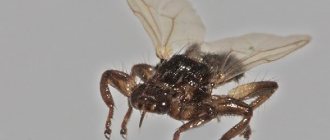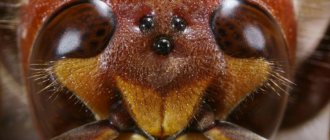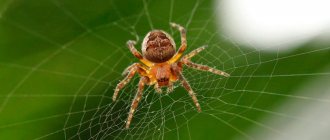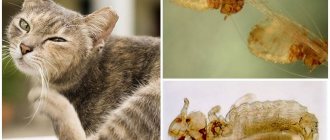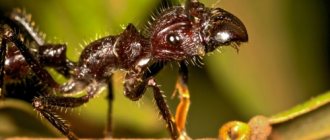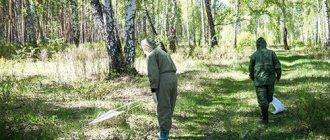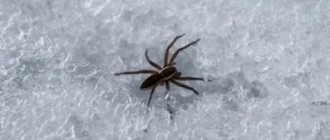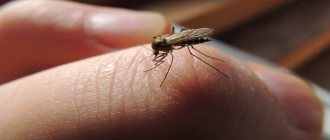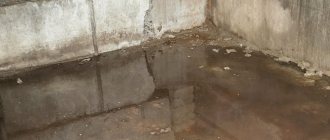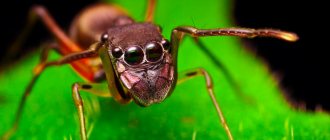Description and features
The wasp is brightly colored.
The pattern on her body is an alternation of black areas with yellow stripes on the body, as well as a pattern of the same color on the head and six legs. Usually the bright color of insects in nature often indicates that this creature is poisonous. Wasps are often the name given to all stinging flying insects belonging to the suborder Stalk-bellied insects, with the exception of bees.
All wasps in the photo look the same, just like in real life, but they may differ in size. They have four transparent wings arranged in pairs. In addition, they have a very powerful mouthparts and faceted eyes, which provide the insect with excellent vision.
Coarse hairs can be observed on their paws, allowing such creatures to grip and hold on to a variety of surfaces.
This insect has two ways of fighting against the enemies that the wasp has in nature: mammals, birds, lizards and others.
First of all, the bright colors themselves provide powerful protection. It frightens the enemy, and hunters of various stripes, hungry for prey, lose their appetite when they look at the wasps. It’s just that their color causes unpleasant associations in many living creatures.
But even if one of the predators foolishly attempts to feast on such an insect, after the first misfire, their desires completely disappear. It's just that the sensations are not very pleasant. Therefore, subsequently, enemies stop making attempts to hunt wasps, having developed a warning reflex in themselves.
But in addition to passive methods of protection, these insects also have active methods. And their poisonous sting helps them in this - an autonomous organ, similar to a dagger blade in appearance and principle of action.
It freely penetrates under the skin of the animal, and also comes out without difficulty, having previously injected its portion of poison. This organ is located at the end of the abdomen, like a bee, because it is an insect very similar to a wasp , also capable of stinging.
But the bites of these two poisonous creatures have a number of differences, primarily for themselves. Unlike bees, who die after using their sharp weapon at least once and leaving it in the enemy’s body, wasps remain alive.
When a wasp stings, it does not leave a sting, unlike a bee.
Moreover, they feel great after a bite and are quite capable of making a new attack. In addition, wasps are endowed with the ability to use not only stings, but powerful jaws when attacking. But, like bees, these insects, sensing the smell of poison released by a fellow insect into the enemy’s body, will certainly enter into battle, collectively attacking the object that caused the alarm.
Externally, these insects are certainly similar, but it is not very difficult to distinguish them even by color. If the wasp is yellow and black, then the stripes on the bee’s body have a slightly different hue, with the addition of orange tones.
Pictured is a wasp and a bee
Where do wasps spend the winter?
On warm summer days, wasps are found everywhere. Before fruits and berries ripen, they conscientiously destroy various pests in the garden and vegetable garden, without causing inconvenience to anyone. And their number is not very large. When the fruits begin to ripen, the number of these insects becomes significant, and they turn into malicious pests, destroying sweet fruits and berries en masse. If in the spring a wasp's nest is small in size and only a few insects live in it, then by autumn it becomes impressive in size, and the number of individuals in it is already in the hundreds. But the nest is exclusively a summer home for wasps. With the onset of cold weather, these hives become empty. Summer residents who remove and burn nests in late autumn know well that there are no insects in them. These actions play only a preventive role, since in the spring wasps prefer to build a nest where there are already old hives.
Before the onset of cold weather, young females fly away after mating and look for suitable places for wintering. As a rule, their winter “apartments” are rotting stumps and fallen trees, and the forest floor of fallen leaves. Females love to climb through cracks under the bark of trees, into the crevices of buildings and under boards. By the period of hibernation, wasps accumulate specific substances in their cells, similar to antifreeze, which significantly reduce the freezing temperature and prevent the destruction of body cells. After finding a suitable shelter, females enter diapause (hibernation). For a safe winter, it is very important that there are no significant temperature changes in the shelter. In harsh winters with little snow, many insects die. Winter thaws are also detrimental to wasps. A significant number of wintering females become prey for birds and small predators. Nevertheless, some insects survive safely until spring.
Working wasps and old females also leave the nest in the fall, but, unlike young females, they do not look for a place to winter, but scatter around the surrounding area and, with the onset of cold weather, become inactive, freeze and die.
In early spring, when the air temperature exceeds 15 degrees, the surviving females will leave their winter shelters and fly to look for suitable places to build nests.
In the fall, you should carry out preventive cleaning on the site - this way you will destroy the “shelters” of wasps that remain to spend the winter in your neighborhood
In the autumn and winter, owners of vineyards and orchards should not relax, waiting for the summer “attack” of wasps on fruit and berry crops. A number of works should be carried out in winter, so as not to waste precious summer hours, which are always in short supply.
- In late autumn, you should check places where wasps may have lived - attics, sheds, corners in sheds and others. Found empty nests should be removed and burned, and the places where they are attached should be treated with some kind of odor-reducing agent. Kerosene, machine oil, dichlorvos, etc. are suitable. This will not harm the insects, since the wasps have already left their nest, but in the spring, the awakened females will look for places to build a new hive. They like to settle near old nests. The absence of old hives and the intimidating smell will force females to look for other places to create a new family.
- With the onset of cold weather (below + 10 degrees), possible wintering sites for females should be collected and burned on the site - old rotten stumps, cut trees. The loose bark should be torn off from dried trunks. Piles of dry leaves should be burned and compost heaps should be poured with boiling water. It is advisable to stir up and turn over or move the boards, pieces of roofing felt and slate to another place. If the wasps have settled down for the winter under them, then, left without shelter, they will die.
- During the winter, you can collect empty plastic bottles and make traps from them. 0.7-liter jars with plastic lids are suitable for the same purposes.
- On free evenings, you can prepare bags for tying bunches of grapes. Gauze, unnecessary tulle or old thin tights are quite suitable for this.
- Preparations should be prepared to combat these insects. It is advisable to stock up on insecticides for baits and traps (boric acid, which is sold in pharmacies, can be successfully used), as well as sprays to destroy nests.
“Armed” in advance, it will be possible to begin the fight against wasps in a timely manner and prevent significant crop losses.
Wasps
How to get rid of a wasp nest under the roof of a country house? V. Chekhun. Lomonosov
First, let's figure it out: what kind of wasps are they and do we need to get rid of them? Most often, paper wasps settle under the roofs of dachas. They are called so because the substance from which they build their nests is made on the same principle as paper: small fibers of wood are ground by the wasps with their jaws and moistened with saliva. Although it is believed that there seems to be no harm from them, I have seen fences and walls of country houses chewed by wasps in places where they are especially widespread.
The presence of wasps in a garden plot can bring some benefit: this predatory insect brings flies, caterpillars, beetles, sawfly larvae and other garden pests to feed its larvae. However, the effectiveness of wasps in the fight against insect pests is low, and they will be successfully replaced by specialized entomophages.
Adult wasps feed on the nectar of flowers, sweet apples, raspberries, gooseberries, pears, and grapes. They are especially attracted to bursting, overripe berries: When foraging for food, wasps are not too aggressive, they can be driven away. But during the period when wasps are nesting, they can attack without any reason on your part.
You can often hear the following recommendations: “don’t touch wasps without reason, and if a wasp starts circling around you, stand still and it will leave behind.” In practice, everything is different. Since the wasp does not leave a sting in the wound, then, unlike a bee, it can sting several times in a row, and does not die after being bitten, so it often makes the decision “to bite or not to bite” in favor of the first.
Therefore, if wasps have settled near you, know: one day they will bite you. You should definitely get rid of wasp nests, especially if someone in the family is allergic to hymenoptera stings.
Knocking down large old nests in late autumn or winter, which is often carried out in country houses, is an energetic but pointless event. Such nests have already served their purpose; wasps do not overwinter in them. With the onset of frost, worker wasps and their larvae die, and the founding females hide in crevices for the winter in order to begin building a new nest in the spring.
In the spring, you should carefully inspect the inside of attics and verandas to see if there are new small nests; at this time they are the size of a walnut. When you find such a nest, quickly remove and destroy it. Having returned, the female will spin around a little and, not finding her house, will fly to another place. This way you will get rid of wasps in your dacha for the whole summer. Sometimes especially persistent females build five or six houses in a row on the same, apparently favorite place. But be persistent - having lost another house, the insect will decide to move to a safer place.
But if your dacha is far from the city, and you yourself are not afraid to take risks, then you can use the old proven method. To do this, you need to choose equipment: gloves, several layers of thick clothing (a padded jacket or an army pea coat is ideal), a face net and a long stick. It is necessary at night (when the wasps are sleeping, preferably at 3-4 o’clock) to fill a bucket with boiling water (the water should reach almost to the edge), place the bucket under the nest and knock it directly into the boiling water with a stick, and then quickly cover it with a lid so that the wasps cook. If you are afraid to touch the nest, you can simply cover it with a thick bag or bag containing cotton wool soaked in insecticide, and keep the bag closed until all the wasps die.
Another method that I have used several times: treatment with dichlorvos. It’s better to do this at night, too, but with enough skill you can do it during the day. The dichlorvos balloon is placed against the opening of the nest and the entire one is etched out (this will take from 3 to 5 minutes), being careful to turn it so that the aerosol gets into all layers of the paper. This method is good if the wasps have settled under a beam or in another hard-to-reach place, and it is not possible to quickly knock down the nest. When using this method, also be sure to protect your face and hands.
O. Vershinina
Lifestyle and habitat
Wasps can be found almost everywhere, in almost every corner of the planet, with the exception of areas that are particularly unsuitable for life. They prefer to settle close to humans, because in the immediate vicinity of people and their homes there is always something to eat.
Now it's time to talk more about the social structure inherent in paper wasps. It is these representatives of the diversity of species already described that should be given special attention, because when they talk about wasps, they usually mean wild social wasps. Although this is not entirely correct.
The groups in which these insects gather to live together are close-knit families called colonies. They can have up to 20 thousand members. In such families there is a clearly established social structure and division into castes with a certain range of responsibilities.
The uterus is engaged in breeding offspring. Worker wasps look after the larvae, feed the rest of the family and guard the common home. The queen builds a nest out of a paper-like material.
It is produced naturally by wasps themselves, by grinding wood and mixing the material with their own saliva. Powerful jaws help these creatures build nests.
With these, the queen is capable of finely grinding hard wood. Worker wasps and drones are on average about 18 mm in size, but the queen of these insects is slightly larger. Males and females are approximately the same color, but females have a slightly larger abdomen. Single wasps may not build nests, but use burrows made by other insects and small rodents.
Where does the wasp live?
Representatives of wasps are widespread throughout the world. They can easily be found in Belarus, Russia, Ukraine, Europe, Africa, Argentina, Canada, Mexico, Australia, China, Japan. Such animals do not live only in the hot Sahara, the Arctic and the Arabian Peninsula. Wasps prefer a temperate climate and cannot exist in regions that are too hot or too frosty.
Interesting fact: A very dangerous species of wasp lives in Japan and China - the Asian hornet. Its size can reach six centimeters. One bite of such an insect is quite enough to kill a person, especially if he is allergic. According to statistics, up to fifty people die every year from the sting of the Asian hornet in these countries.
Most representatives of wasps live in the Northern Hemisphere. Only a small population can be found in Brazil. These insects choose their habitat according to several criteria: temperate climate, presence of trees, humans. The thing is that the human habitat makes it easier for wasps to get their food. The tree is used for building nests and raising larvae. Some individuals build homes from clay and pebbles. Their nests look very much like small castles.
What kind of homes do wasps have?
An example of a social wasp's nest is the home of hornets, the largest stinging insects of the suborder Stem-bellied. The whole process begins with one uterus. Its task is to create a small ball where nests could be made for several working individuals.
First, the uterus creates one layer, moving from the center to the periphery. Under this layer she makes a leg to which several cells are attached. Eggs are laid in each of them. After this, the queen builds several tiers until new workers appear from previously laid eggs. The more workers appear, the more extensive the wasp’s jaws create a paper ball, and the queen, meanwhile, is engaged in her direct function - reproduction.
In biology, this group includes all insects belonging to the order Hymenoptera and the suborder Stalk-bellied.
The nests of the solitary wasp are very diverse. Thanks to the research of the famous insect behaviorist Jean Henri Fabre, the life of the burrowing ground wasp became known not only to scientists. These predatory wasps inject a paralyzing injection into the nerve center of a large spider, drag the poor thing into a hole, and then lay eggs on it. Soon the larvae emerge from the eggs and begin to eat the spider alive.
The flower wasp builds its cells somewhere in secluded places. Pill wasps (aka pottery wasps) make nests from earth and clay. It looks like a bandoleer for 3-4 rounds, which is hidden in the forest canopy. However, pottery wasps get along well with humans, disguising their cartridge belt on the walls of houses and even inside a person’s home.
Some wasps dig small shelters in plant stems. Finally, there are species that do not burden themselves with any construction work at all. They simply use natural depressions as their humble home.
How social wasps overwinter
The usual wasp nest is a summer house, which becomes empty with the onset of cold weather. Where wasps hibernate in winter and how they do it depends on the type of insect. The most common and well-known are social wasps, or as they are also called, paper wasps. Their family practices division into castes, with the fertile female at the head.
The largest number of insects of this species appears in mid-summer, when vegetables and fruits ripen, a stable warm temperature is maintained outside, and there is an abundance of food. However, with the onset of cold weather, around mid-autumn, wasps disappear from their nests and are not active in the wild.
The main question is whether these insects fall asleep or die, where they can go.
Wintering of wasps requires females to search for suitable places and does not provide for the storage of food supplies or the construction of special shelters. Wasps overwinter in nature under rotten stumps, in abandoned hollows, and under the bark of trees. Domestic inhabitants who set up nests under the roof of outbuildings, in attics, on balconies, hide in cracks for the winter.
Where and how do wasps that live under the roof of a house overwinter? Do they die in winter?
Wasps often build a nest under the roof of a house in a summer cottage, in a basement or on a balcony. This causes a lot of inconvenience and is dangerous to health, because a swarm can attack, sting and spoil food.
It is difficult to cope with this scourge in the summer; the wasp brotherhood does not sleep and fights back anyone who tries to attack their home. And with the onset of cold weather, the nest becomes empty.
To drive away dangerous insects once and for all, you need to figure out where wasps spend the winter and whether they will return to their home after winter. Should an empty nest be destroyed?
Where do they winter?
After fertilization, instinct stimulates females to search for suitable housing in which they will spend the winter. Wild wasps choose places that can retain heat. A reliable shelter is the bark of trees, in which insects gnaw holes.
The walls of the wasp's winter home are soaked with saliva. This makes them stronger in order to further protect sleeping residents from bad weather and attacks. After that, they fill it with food reserves for the winter so that they have something to feed their offspring.
Social wasps (paper wasps are their second name) accumulate nutrients in the body all summer, and do not wake up to snack in winter. Old stumps, firewood supplies, boards stacked for construction and wooden floors under the roof are often used to hide wasps in winter.
Gaps in the walls of residential buildings, which are properly heated in winter, are also suitable.
It's good if a snowy winter comes. The aspen shelters are covered with snow and the females will calmly survive the cold. But if the weather becomes rainy, water gets into the holes and the insects die.
Expert advice: to get rid of these pests on your site, you need to try to find winter shelters and destroy them. Because if this is not done and the empty nests are simply destroyed, an unpleasant surprise may await the owners of their country house in the spring.
Will wasps return to a hive under a roof in the spring?
After winter, the female wasps wake up. This happens when the air warms up to +15 degrees. Now they need to find a home for the warm season in order to place their offspring in it. Their appearance will not be noticeable immediately. At first, the wasps will set up their home and actively reproduce. And by mid-summer you can observe a full hive of young individuals.
Natural instinct calls the females to return to their native land. Therefore, if you do not destroy the houses of striped insects in the winter while they are empty, then in the spring a new family will settle there. How to effectively destroy a wasp nest:
- remove and throw away away from home;
- burn;
- treat with Dichlorvos or boric acid;
- sprinkle with bleach or a special repellent compound (“Raptor”, “Get”, “Alatar”).
Important: even if the nest was physically destroyed, the place where it was located must also be treated with a chemical composition. Otherwise, wasps can simply build a new home in place of the old one in their familiar territory
You can help move the swarm to a new location, away from people. For this purpose, comfortable areas are created, protected from bright light, wind and moisture. You can lure them with sweet fruits and water with sugar.
It was not for nothing that the wasp appeared in nature. At first glance, these insects are of absolutely no use, but rather the opposite. But in fact, striped ones destroy clouds of pests in the garden in order to feed their offspring.
They also promote the reproduction of flowers and plants and carry pollen. And if you do not anger them and do not interfere with the period of conception of offspring, then wasps can exist peacefully next to humans. The life cycle is short, but they accomplish a lot in a year.
Until the last days, they help the offspring survive so that the food chain is not disrupted.
Useful article, thank you! 1I don’t like it, delete it!
Variety of species
The wasps that are familiar to most of us and have yellow and black stripes on their bodies are called paper wasps. This species name is due to the fact that the material from which insects build their homes is very similar to paper. It is made from wood fibers chewed by arthropods, which are glued together with saliva.
Other types of wasps have different colors. The size of the insect depends on its species. They range from 1.5 cm to 10 cm. What do wasps eat? The adult eats mainly liquid food - nectar, fruit juice. For their larvae, wasps get: flies and other insects. Predatory wasps themselves eat insects, and can also feed on other types of food.
The wasp catches its prey and injects its poison into it through its sting, which does not kill, but only paralyzes. Thus, the meat of the prey is kept fresh until the time of the meal.
Different types of wasps live almost everywhere. For example, ground wasps choose soil to build their “homes”. Paper wasps build their “family nest” under a tree branch or on any structure. It should be noted that wasps are very willing to settle near people. This proximity makes it much easier for them to find food. The wasp eats sweets and other foods left in a visible place in a person’s home. But also, it catches pests there such as flies, which carry various infections and thereby brings benefits. In the garden, wasps can find not only flies and ants, but also a huge number of insects that are pests. Wasps love honey very much and therefore pose a threat to bees.
The queen is the largest individual of the paper wasp family. The length of its body is approximately 20 millimeters, while the body length of a working wasp or drone is about 18 millimeters. Females have a larger abdomen than males. Insects do not differ in body color by gender. Males and females have the same yellow and black striped color.
Reproduction
The future queen builds a honeycomb, in the cells of which she lays eggs. After a few days, carnivorous larvae appear, demanding meat food. During this period, the female is actively engaged in the destruction of tree pests; they serve as food for the growing larvae. The first wasps are sterile females and will assist the queen in caring for the next generation and building the nest.
In August and September, young queens and males will appear ready to mate for reproduction. After fertilization of females, most males die. Old queens that have lost the ability to lay eggs will not survive the second winter. They will die along with the workers. Among the many species of paper wasps, there are females whose life cycle is 2-4 years. They enter a state of winter sleep several times.
Information. What do wasps eat in winter? Before the onset of cold weather, females try to accumulate more nutrients in the body. After entering diapause, they become so passive that they survive the winter due to accumulated substances.
Birth and nest construction
Wasps are not noticeable in winter and early spring, but with the onset of stable warmth, the first scouts fly out. These are future queens who, since last autumn, have been storing in their bodies the sperm of the males who fertilized them. Insects look for the first flowers to feed on nectar. The young female will have to fulfill the main function of her life - to give birth to a new family. She finds a suitable place and begins building a nest. The material is chewed tree bark, generously moistened with saliva. After drying, the substance becomes like thick paper.
Main distinguishing feature
The life of a wasp depends on whether it is a social or solitary individual. Already from the name it becomes clear that the former live in families, and the latter – separately. This division exists in all numerous insect species. Each single individual has the opportunity to reproduce. In the family, only the uterus continues the family line.
Solitary wasps prefer not to live in large groups. They mate and then lead a solitary life. Paper single females build their nest. In each cell, in addition to the laid egg, the female places a supply of food for the impoverished larva. These are small insects and spiders paralyzed by poison. Having filled the cell, the female seals it.
The larva eats the supplies prepared by the caring mother and develops inside the cell. When it reaches maturity, it gets out of the nest on its own. Young insects fly away in search of a place to build their own “home”.
Aggressive insect
The peculiarity of the structure of the ridge allows the head to move very well. The mouthparts of an insect are of the gnawing type. It is designed to grind food and wood fibers used in the construction of honeycombs. Stripes have a serrated sting, which does not have a knot at the end, but the serrations are smaller than those of a bee.
Only females have a sting. After all, in essence, it is an ovipositor, through which, if danger arises, the “minke whale” can also spray poison. But wasps are quite aggressive and prefer to attack first. Females quite often use the sting for purposes other than its intended purpose.
Nature dictates that the bright yellow-black color makes the insect very noticeable and thereby warns other animals that its owner is poisonous. The minke whale stings and bites its opponent. Although the bites are less painful than the venom released by the stinger.
It should be borne in mind that minke whales attack at the slightest disturbance - this demonstrates how dangerous they are to their enemies. When biting, it does not leave a sting in the body of its “victim”, as bees do. Therefore, insects do not die after being stung. They may repeat the attack again.
It is very important to know that the venom of the striped insect has a smell. If one wasp stung and another was nearby, it will smell the poison and fly to the aid of its “relative.”
It is especially dangerous to disturb a formidable arthropod near its home. Then the whole family can attack. It’s not for nothing that there is a saying “to stir up a hornet’s nest,” which implies major troubles.
Medicine from a wasp's nest
But the efforts of hardworking bees are not in vain; a knowledgeable person, having discovered an empty wasp nest, will definitely take it with him. For what? To prepare medicine. Yes, that’s right, a wasp’s nest can be of great benefit. It, or rather, drugs based on it, are quite actively used in folk medicine to treat various diseases. For example, if you compress several of these nests (empty, of course, without insects), put them in a jar and fill them with alcohol, then after two weeks of infusion you can get a highly effective remedy that helps in the following situations:
- for joint pain;
- for pain in the spine;
- for arthritis;
- for inflammation of joint tissue;
- for various forms of viral influenza;
- for bronchial asthma.
The infusion helps to eliminate the problems described above when applied externally - in the form of rubbing. As for its internal use, it shows very good results in the treatment of inflammatory processes occurring in the gastrointestinal tract, in diseases of the respiratory tract and pneumonia. In such situations, 15 drops of infusion are diluted in 50 ml of water and taken three times a day.
The second way to use wasp nest is in powder form. This simple one-component drug heals burns, cuts and other damage to the skin well. Moreover, it not only stimulates tissue regeneration, but also disinfects the affected area. Powder made from crushed wasp houses can also solve the problem of periodontal disease. It copes well with sweating feet and eliminates unpleasant odor.
You can store preparations from wasp nests for several years and their strength will not decrease.
Causes of wasps
Wasps in the house can appear for various reasons, among which it is worth highlighting the most important:
- They can be lured by various foods - meat, fish, fruits, sweet foods;
- A warm and comfortable place to locate your nest;
- Nesting for the purpose of overwintering. These insects often fly to private homes in the fall to spend the winter. Everyone knows that insects die in severe frosts;
- They can get into the house by accident. Often these creatures enter the house accidentally, for example, in search of food or water. If one wasp flies into it, then soon a whole swarm will live there.
Knowing these reasons will help make the process of controlling these insects easier. It is enough to simply create conditions in which these creatures will not be able to live.
Wasps attack people for no reason
Wasps are considered one of the most dangerous insects, stinging their prey. Like all things stinging, the wasp is considered a predator whose bite brings a lot of pain. After a bite, a person feels severe pain, after which other unpleasant symptoms may appear.
The first reason why wasps attack is an attempt at defense. Like any predator, the wasp is evil by nature, so any confrontation with it is perceived as an attack. Usually such fights only end in bites.
The distinguishing signs of a wasp sting are:
- Instant redness and swelling of the bite site;
- The pain is accompanied by severe itching;
- The appearance of an allergic reaction;
- The whole body begins to itch, a rash appears;
- In the place where the sting occurs, acute pain appears;
- Anaphylactic shock.
Additionally, the following may appear:
- severe dizziness;
- vomiting, nausea;
- acceleration or deceleration of heart rate;
- increase in temperature.
Note! The most dangerous symptom is considered to be anaphylactic shock, which most often affects allergy sufferers. Moreover, if qualified medical care is not provided within a short time, a person may die from a wasp sting
Do wasps die in winter?
In autumn, when the air temperature steadily drops, wasps gradually begin to disappear. They no longer circle over sweet fruits hanging on trees or fly into houses. The thing is that most of the adult individuals die with the onset of cold weather, and the remaining ones hide in secluded corners until spring.
To understand why this happens, we need to take a closer look at the process of wasp reproduction. All summer the queen reproduces sterile worker wasps. And only at the end of summer do males and females capable of fertilization begin to appear. They actively mate, after which the males, whose main task is completed, die.
The same fate awaits worker wasps, who live for about 1.5–2 months and fall asleep when the temperature drops below the critical mark of +10⁰С, and die with the arrival of real cold weather. The queen leaves the nest in the fall, like other insects, and also dies with the onset of cold weather.
As a result, only fertilized females remain for the winter. They hide in secluded places, fall into suspended animation and sleep until spring.
When wasps sleep
Insects lead an active lifestyle during the day, each individual performs its own functions. With the onset of dusk, they return to their nests or look for a secluded place among the grass, flowers, and trees. They gather in groups or may fall asleep alone. In summer, wasps sleep all night until dawn. In the open air they cling to the base with their paws and jaws. They can spend the night in the hive in a free position.
A similar condition occurs in winter. However, in this case, sleep lasts much longer and is called suspended animation. Insects are capable of hibernating at certain temperatures. Insects awaken only with the onset of warm days.
The temperature at which wasps begin to gather for the winter ranges from +15 to +10 degrees Celsius. Working individuals at such rates begin to die without waiting for winter. They wake up in the spring with temperatures rising to +10 degrees Celsius.
Initially, the young female looks for a favorable place to build a nest. In most cases, it returns to where it was born and begins to settle and settle. The behavior of a young queen is hardly noticeable. She is busy laying eggs. Only after the appearance of the first adult working individuals does active life begin. Insects fly around the surrounding area, get food, and carry out their duties. Peak activity occurs in June-August. Working females live no more than 3 weeks. Males die after mating.
To avoid repopulation of the wasp family, summer residents and owners of private houses destroy empty nests in the fall and winter.
I remember back in the day, when my grandmother still had her own dacha and had the strength to cultivate it, the ceiling of a small wooden barn house was full of gray wasp nests - some smaller, some larger. It's a pity that there are no photographs left from that time.
Read on Dacha6.ru:
Characteristic multi-layer balls with a lower entrance can be seen in the dressing room of a bathhouse, in a barn, or in the attic of a residential building. Is it safe to remove them in winter and, in general, where do wasps wait out the winter?
In autumn, when the length of daylight hours noticeably decreases and the ambient temperature drops, fertilized queens begin to look for secluded places for wintering. They can be found in the old, peeling bark on trees and stumps, under which you can properly go deep, and where birds cannot reach them, various crevices in outbuildings, accumulations of dry leaves, fallen boards, compost heaps, etc.
The insects fold their legs and fall into a kind of hibernation. Over the course of a long winter, they will slowly use up the reserves accumulated over the summer-autumn (this is why wasps are so annoying in late summer-September). Interestingly, the body of wasps in winter produces a substance whose properties resemble antifreeze. Because of this, they manage to remain viable even in severe frosts. Insects will wake up only in the spring, when the air temperature rises to +14 C.
The queen will lay the first layer of a new nest with a small number of cells on her own. The material for construction is crushed tree bark, generously mixed with insect saliva. When the composition hardens, it becomes like parchment paper.
Without wasting time, the queen lays eggs in the first formed combs. When female workers emerge from the eggs, they completely take over all construction work. The uterus can finally focus solely on reproduction. Subsequently, the size of the nest can be used to judge the size of the colony.
Wasps do not remain in the gray nests left over from the summer, even large and multi-layered ones, and they also do not return to them. Therefore, winter is the right time to get rid of them safely.
Also try to remove dry leaves, cut trees, and rotten stumps from the area in the fall. Remove all boards and pieces of slate from the ground. Pour boiling water over the compost heaps thoroughly.
And although the queens do not return to old nests, they build new ones in approximately the same places. Therefore, in April, treat the premises where wasps were previously actively nesting with any composition that repels them (Dichlorvos, machine oil, etc.). The overwintered queen will prefer to choose a more suitable place to lay a new nest.
Have you already cleared the attic and shed of wasp nests or are they not bothering you?
Preparing for winter
In the fall, they scatter around the surrounding area and after that they no longer show their former activity and become much more vulnerable, sleepy and inactive. The fate of each individual individual develops differently. Some of them simply live out their lives as summer ends. After that they freeze.
If we are talking about fertile and fairly young females, then they usually mate at the very end of August, and then simply sleep in a secluded corner. This is necessary in order to continue life after the onset of spring (with the onset of heat). At the end of the season, the males die, as well as the working females and the old queen. It also happens that fertile females are born only at the very end of the season.
Another circumstance that has a strong impact on the situation with these insects is the slowdown of metabolic processes in the body of the uterus. After this, preparations for wintering begin. The body temperature of these insects begins to drop to a minimum level, which will help cope with freezing on too cold winter days. Wasps in winter are able to withstand even the harshest conditions if they manage to find a secluded place.
Wintering process and diet
If anyone is interested in what wasps eat in winter, then essentially nothing. Since they fall into suspended animation, all processes in the body, including metabolic processes, slow down significantly. The wasp not only doesn’t eat, it doesn’t even move and practically doesn’t breathe. However, nature has arranged it so that even in hibernation, the insect’s body receives nutrients. The female has been accumulating them since the end of summer, when she begins to actively eat, absorbing more food than usual. So, when flying away in search of winter shelter, the wasp already has a decent supply of nutrients, which helps her survive the cold winter.
Where do they winter?
The most common version is that after the wasps leave the nest with the onset of cold weather, they look for a place where they can overwinter. But there is another one - insects are looking for a place to winter not in the fall, but starting from the end of summer. In any case, the shelter in which the wasp will spend the winter must maintain a constant temperature and be as closed as possible from wind and frost. That is why in the fall, wasps sometimes actively climb into a house, barn, or bathhouse, hiding in cracks and crevices.
Most often in nature, wasps spend the winter in places such as:
- tree bark (insects gnaw holes in it or get into existing cracks);
- in old rotten stumps;
- in rotten fallen trees;
- in a heap of fallen leaves.
Wasps moisten the walls of their winter shelter with saliva. Thanks to the enzymes it contains, the wood becomes denser and better protects the female until the weather warms up and she can fly again.
Where do wasps spend the winter in nature?
Many people are interested in where wasps spend the winter. Usually, before the start of winter, wasps begin to actively mate. After this, they leave in search of a place where they can spend the winter. What attracts these insects most? They prefer fallen trees; many like to spend the winter in rotten stumps. They become a place of hibernation for many wasps. The same can be said about autumn leaves. They form excellent bedding that both females and males love. That is why, in order to overwinter in the autumn leaves, they have to fight other insects.
The best wintering is in Thailand))
Female wasps spend the winter in cracks in tree bark. They feel quite comfortable there. It is really easier to winter in these places. If there are too many cracks in a house located on an area with these insects, then the wasps may remain overwinter there. The main thing that everyone who lives next door should remember concerns their wintering place. Under no circumstances should they end up on the inside of the house. In addition, these insects often prefer to winter in old barns, as well as in any other wooden structures.
Insects are very picky about where they live. They do not like large temperature changes. That is why the place where wasps overwinter is chosen with special care. The fact is that a harsh winter or little snow can cause the death of many females. Moreover, these insects often become easy prey for birds.
Wasps do not like to hibernate, since winter is a dangerous time not only for them, but also for any other insects. Despite all the hardships, a significant part of the females still survive after hibernation. The new generation appears quite quickly after the end of wintering, so today this species is not threatened.
Wintering process
Wasps live in winter in places hidden from human eyes. In most cases, in wood. They can hide and sleep under the bark, in old stumps, abandoned hollows, and crevices. Snowy winters contribute to successful wintering. The thaw has an unfavorable effect when the ice cover melts, the cracks become open to wind and frost. Unfavorable weather conditions, as well as natural enemies, prevent insects from overwintering.
In the wild, insects become victims of birds and animals. Bears deliberately tear open old hollows and eat prey before the insects can get out in the spring. Whether or not wasps sleep in winter is a controversial issue. This is a unique condition, as a result of which activity is lost, metabolic processes slow down, and nutrition as such stops. Wasps become inactive during the winter and save energy. With the onset of warmth, they awaken and continue normal life activities.
Wintering places
In the summer, wasps can be found almost everywhere in nature. Before the fruits ripen, these insects actively eat pests. Their numbers are usually small. However, as the fruits ripen, the number of insects increases.
The first young wasps are sterile females. They help the queen care for the new generation and build a nest. At the end of summer - beginning of autumn, young queens and males mate. With the arrival of cold weather, the nests quickly become empty: most of the male and working individuals die.
And young females choose places that are completely hidden from human eyes as their winter “dwelling.” In most cases, this is the thickness of wood, old stumps and cracks in outbuildings or houses.
Video: How bees prepare for winter
Note that not all species have young wasps that help the queen. In most cases, they scatter around the surrounding area and establish their own colonies, and their mother alone builds a “hive” and raises the young. Only after they have matured can she focus on laying a new batch of eggs.
Since wasps overwinter in old trees, wild boars often take advantage of this. In the southern regions, they often search all rotten stumps, looking for “sites” of the insects in question. However, in the summer they do this no less willingly, since wasp larvae are a delicacy for them.
Note that there are genera Vespula and Dolichovespula, in which the worker caste has completely disappeared. After overwintering, their queens lay eggs in the nests of other species and then mate with the grown males. They do not build their own nests.
We hope that you have learned about the places where wasps spend the winter. As you can see, this is very interesting!
Attention, TODAY only!
Wild bees spend the winter in hollows, while domestic bees spend the winter in their hives, which are installed in special winter huts. Not everyone knows where wasps spend the winter, since in the fall they fly away from their nests, leaving them completely empty. In spring, only a few individuals appear. These insects reappear in large numbers only in mid-summer.
Fighting wasps in the autumn-winter period
Prepare your sleigh in the summer, and start fighting wasps in the winter. Just because wasps have left their nests for the winter doesn't mean they won't return in the spring. Therefore, certain work must be carried out while there is no one in the nests, or rather, as soon as the temperature outside the window drops to 9 - 10 degrees. This makes the task much easier.
First of all, it is necessary to carefully examine their possible wintering places - attics, sheds, all dark and dry corners. Look into every crevice where wasps could possibly live. If boards and other things are piled up on the site “just in case,” they should be moved to another place or rearranged. If wasps were hiding there, then if they were left without a roof over their heads, they would quickly die.
If you find a nest or something similar to it, remove it carefully and destroy it. The place where you found the remains of a wasp nest must be watered with something with a strong and pungent odor. Kerosene, for example, or dichlorvos. These measures will lead to the fact that next year the wasps will look for other nesting places. In addition, before snow falls, it is necessary to collect and burn fallen leaves, if possible, remove dry branches and trees from the area, or peel off the bark from them. Thus, we will significantly reduce the number of places where wasps can hide for the winter. The right owner will not forget to replenish supplies of insecticides. In winter, they are needed much less and, accordingly, their price is lower. Whether to collect plastic bottles for traps or not is something everyone will decide for themselves. Considering that almost all liquids are sold in such bottles, it is not advisable to collect and store them all winter.
Sources
- https://givnost.ru/osa-nasekomoe-opisanie-osobennosti-obraz-zhizni-i-sreda-obitaniya-osy/
- https://klopkan.ru/osy/kak-razmnozhayutsya-osy-zhiznennyy-tsikl-skolko-zhivut/
- https://dr-dez.ru/muhi/gde-zimuyut-osy-zhivushchie-pod-kryshej.html
- https://klopkan.ru/osy/gde-zimuyut-osy-esli-osenyu-ih-gnezda-pusteyut/
- https://WikiParazit.ru/osy-i-pchely/kak-zimuyut-i-chem-pitayutsya-osy.html
- https://queenbee.ru/osy-shershni-i-shmeli/gde-zimuyut-osy
- https://apest.ru/osy/ob-osah/zimuyut-osy/
- https://DomPchel.ru/pchelovodstvo/poleznoe/kak-zimuyut-osy/
[collapse]
